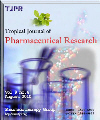
|
Tropical Journal of Pharmaceutical Research
Pharmacotherapy Group, Faculty of Pharmacy, University of Benin, Benin City, Nigeria
ISSN: 1596-5996
EISSN: 1596-5996
Vol. 15, No. 2, 2016, pp. 415-419
|
 Bioline Code: pr16055
Bioline Code: pr16055
Full paper language: English
Document type: Research Article
Document available free of charge
|
|
|
Tropical Journal of Pharmaceutical Research, Vol. 15, No. 2, 2016, pp. 415-419
| en |
Comparison of Sterile and Clean Dressing Techniques in Post-operative Surgical Wound Infection in a Chinese Healthcare Facility
Huang, Xiao-ling; Zhang, Jing-qi; Guan, Shu-ting & Liang, Wu-jin
Abstract
Purpose: To investigate the effect of sterile and clean dressing techniques on wound management in a
Chinese hospital, and to compare their impact on wound healing and the cost of the dressing materials
with respect to postoperative surgical wounds.
Methods: A total of 130 patients, comprising 70 (53.8 %) males and 60 (46.2 %) females, who had
undergone surgery in The Affiliated Hospital of Changchun Traditional Chinese Medicine University,
Changchun, China in 2012 – 2014 were enrolled in the study. Of these, 65 (50 %) received sterile
dressings and 65 (50 %) clean dressings. A control group comprising 25 patients, 15 (60 %) males and
10 (40 %) females, who attended the clinic for change dressings only, was also included. The patients’
dressings were changed four times daily with 2x sterile and 2x clean dressings. Details of all the
changes, including the nutritional status of the patients, were recorded. The patients were followed-up
up to the time of their discharge.
Results: Twelve (18.5 %) patients out of those who received sterile or clean dressings were found to
have acquired an infection. The size of the wounds was approximately 1.8 to 32.4 cm3 (mean: 5.2 ± 6.4
cm3) in size at the start of the study and 0.6 to 4.2 cm3 at the end of the study. A significant difference
was identified between the sterile and clean dressing groups at the beginning of the study (U = 72.5; p <
0.12). A decrease in wound size was observed in both of these groups but was not statistically
significant, while the change in wound volume, was significantly different (U = 84.5; p < 0.25). When the
cost of the two dressing types was compared, the sterile items were more expensive than that of the
clean items; thus, sterile dressing procedure was significantly more costly than clean dressing
procedure (p < 0.01).
Conclusion: With mounting concern regarding antimicrobial resistance and hospital-acquired
infections, suitable wound dressing techniques are required to prevent infection and reduce the duration
of wound healing after surgery without compromising patient safety.
Keywords
Wound dressing; Postoperative; Antimicrobial resistance; Hospital-acquired infections
|
| |
© Copyright 2016 - Tropical Journal of Pharmaceutical Research
Alternative site location: http://www.tjpr.org
|
|
